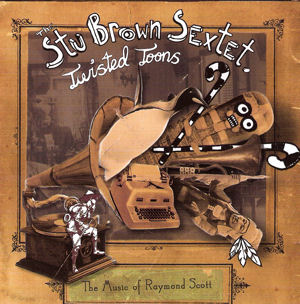1. Square Dance for Eight Egyptian Mummies
2. Devil Drums
3. The Penguin
4. New Year's Eve in a Haunted House
5. The Toy Trumpet
6. Boy Scout in Switzerland
7. Suicide Cliff
8. In an 18th Century Drawing Room
9. Moment Musical
10. Powerhouse
11. Egyptian Barn Dance (piano solo)
12. Hypnotist in Hawaii
13. Dinner Music for a Pack of Hungry Cannibals
14. At an Arabian House Party
15. Tobacco Auctioneer
16. Twilight in Turkey
17. War Dance for Wooden Indians
18. The Bass-Line Generator
19. Toy Typewriter
Stu Brown - Drums, celeste, xylophone, tubular bells, squeaky toys,
Vintage Petite toy typewriter, programming (tracks 1-17, 19)
Tom MacNiven - Trumpet (tracks 1-17)
Brian Molley - Tenor sax, baritone sax, alto sax, soprano sax, clarinet,
squeaky toys (tracks 1-18)
Martin Kershaw - Clarinet, crumhorn (tracks 1-17)
Tom Gibbs - Piano (tracks 1-17)
Roy Percy - Double bass (tracks 1-17)
Raymond Scott is not exactly a household name - nor is he well known
even to jazz fans. Yet he was an inventive American composer, arranger,
bandleader and pianist (real name Harry Warnow), who led groups in
the 1930s and 1940s which included such jazzmen as Charlie Shavers,
Emmett Berry, Cozy Cole and Ben Webster. Despite leading jazz bands,
he was most noted for his novelty numbers: such tunes as The Toy
Trumpet and the Mozart pastiche In an 18th Century Drawing
Room. Many of these were heard in Warner Brothers' cartoon series
like "Looney Tunes" and "Merrie Melodies".
Glasgow-based drummer Stu Brown was so intrigued by Raymond Scott's
compositions that he formed a sextet to give concerts of Scott's music
and to record this album, which contains many transcriptions from
original sources. Much of the music is arranged, although there are
a few jazz solos.
You can tell that the sextet is led by a drummer, as the drums are
prominent on most tracks, although the piano is virtually inaudible
(except on Egyptian Barn Dance, which is a dainty piano solo).
Stu Brown often lays down a marching beat with plenty of drum rolls,
which can create a stilted effect. Yet the band performs with gusto
and the right sort of tongue-in-cheek approach which novelty tunes
require. The music is cheerful and often intriguing - which is why
much of it found a happy home on the soundtrack of cartoons.
The last two tracks are particularly novel. The Bass-Line Generator
is played solely by Brian Molley on four different saxophones
and one clarinet, with the help of overdubbing. And Toy Typewriter
is performed by Stu Brown on a real toy typewriter, programmed to
make a variety of noises. My only complaint about the album is that
the sleeve information is printed in black on a brown background,
which makes it very hard to read.
As we are near Raymond Scott's centenary (he was born in 1908 - or
was it 1910?), it is fitting that he should be celebrated through
projects like this. As well as being a resourceful composer, he was
also an inventor: creating an early form of electronic synthesiser
as well as a talking alarm clock!
Tony Augarde
